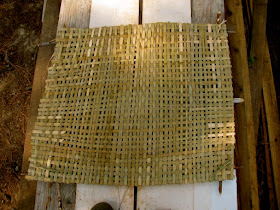 |
| Woven Cattail Mat |
Cut bundles of leaves just above the water level, leaving the plants with seed heads alone. A decent armload of leaf bundles should give you plenty of leaves to work with. You can cut off most of the white, thick, curved bottom parts of the leaves as you only want to work with the flat green leaves.
Then separate the leaves from each other and lay them out to dry individually in the shade. Keep moisture away or the leaves will rot fast. You can either dry them fully (they become very britlle then) and then rehydrate them in a wet towel overnight when you're ready to work with them, or start working with them after they've wilted for a couple of days but are not yet brittle, knowing that the leaves will shrink some more as they continue to dry.
 |
| Individual Cattail Leaves |
I start the mats with four leaves in a basic over-and-under pattern.
 |
| Starting the Cattail Mat |
If I'm working with just-wilted leaves I like to add a new leaf on each side as I go around and around, still using the same over and under pattern. It's important to keep the mat as square as possible as you do so, and it's preferable to have a fairly tight weave as the leaves will shrink and create more spaces.
If I'm working with dried leaves that were just rehydrated and I know I won't finish the mat in one sitting, it may be easier to only keep one side of the mat moist and add leaves only to that side, while leaving the rest dry.
 |
| Woven Cattail Mat |
If the gaps between the leaves are too large for what you want to do with the mat you can rearrange them to make them tighter.
When you only have about 5 inches left on each side of the mat, it's time to think of finishing it up. You can fold the leaves over the mat and weave the ends into the other side to hold them tight (make sure the leaves are very pliable before you do that or they may break).
 |
| Edge of Woven Cattail Mat |
You can also choose to wrap the end of the leaves around a stick to give it more support during transportation, still weaving them into the other side.
 |
| Edge of Cattail mat around a Stick |
 |
| Frame underneath the cattail mat |
You can also add a frame underneath the mat to create more airspace and to make it easier to transport.
In this case, it's simply two sticks along the edges with three more sticks laid across them.
These sticks are lashed together with rehydrated cattail leaves spun into cordage and they are attached through the mat to keep it in place.
 |
| Frame held by Cattail Cordage |
Don't try to fold the mat when you move it and store it or it may break. And make sure that it is stored away from any kind of moisture or the leaves will deteriorate quickly.
 |
| Putting the Cattail Mat to Good Use! |
this is really cool, there is just some things I'm not sure I understand...
ReplyDeletethis mat, can not be used as a roof on a survivalist shelter; it can not be used to sleep on; the only thing it CAN BE used for, is a drying mat for food or other stuff....
Is that correct?
Another plant that is good for the survivalist, is a plant called "flags"...
I doubt that is the actual name of it, but you will find them growing in and around marshes/wet lands; along the sides of main Highways where it is wet most of he year...
For lack of a better description, they look like a doll rod with a flag on top of it....
I would cut them of at about 4 - 5 feet long, set them out to dry in the shade, as they are drying, I would trim them up to make them look pretty....
after they dried completely, I would use 100% cotton string to weave them together in mats about 5 feet long, melt some pine sap til it's a liquid, & then "paint" the mats with this(3 -5 coats).
They make excellent roofing material(summer only) & they also make for a good base layer if you plan on using animal hide, bark, or some other medium for fall & winter to cover your shelter.
Hi James,
DeleteSorry I hadn't seen your comment before now. My comment-moderating setting was changed for whatever reason.
This post was just to show that you can cross-weave cattail leaves in order to make drying mats with them. But you can of course use them differently for other uses. I actually built a whole shelter with small bundles of cattail strung together and it worked quite well for several years, year round. Unfortunately I've lost those pictures.
And, like you described, you can make mats with leaves tied together with cordage/thread and those mats can be used for flooring and removable roofing, similarly to tule.
The 'flags' plant you are referring to is probably some species of iris, which grows in similar environment as cattail. Their leaves tend to be wider but shorter than that of cattail.
Cattail mats can be used for sleeping on (they are good natural insulators and they have spongy cells called aerenchyma which make them comfortable). They are also used to build summer wigwams. You can learn more from one of the greatest experts of all on everything botany and indigenious knowledge - Robin Wall Kimmerer in her book Braiding Sweetgrass.
DeleteGreat work.
ReplyDelete